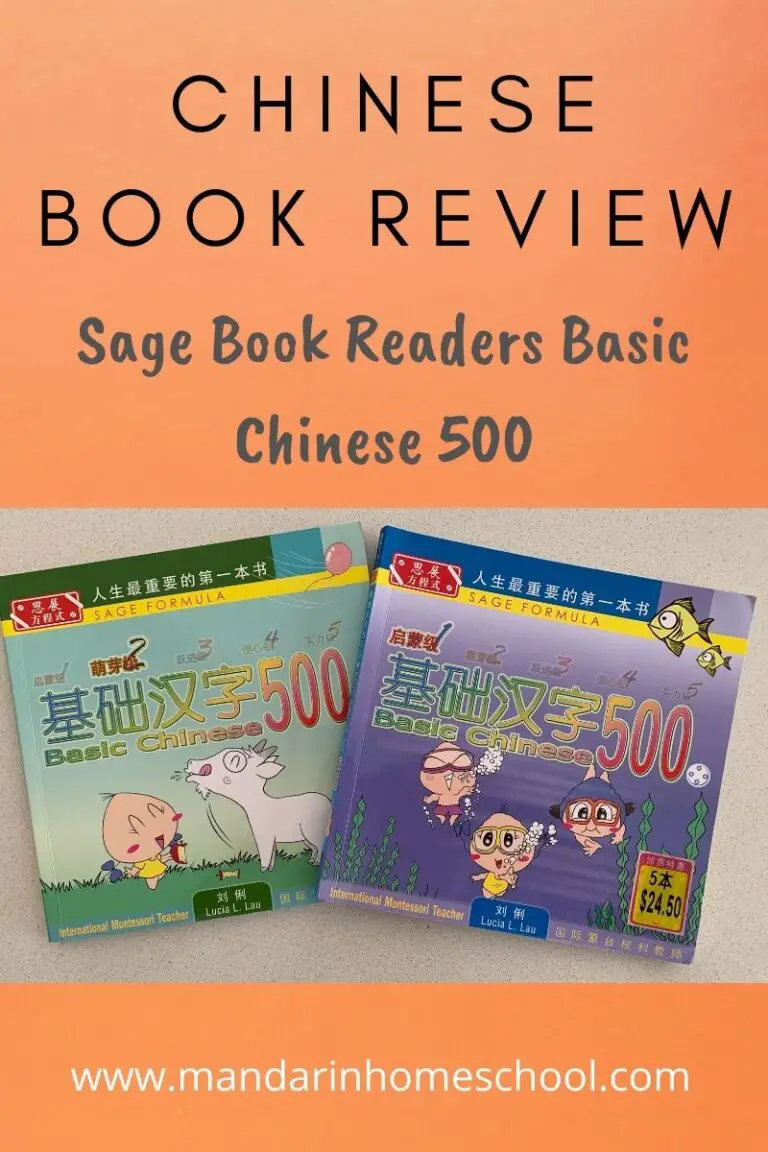
Chinese Sage books. If you are in the market for a Chinese leveled reader, you have most likely heard of this series.
I have been using this with my three children for the past two years. I only intensively used it with them when they turned 3. And this is my honest review of the effectiveness of the Sage Book readers in helping my children read Chinese.
What are Sage Book Readers?
Sage books are based upon the company’s Sage Formula 思展方程式, and are a series of picture books covering 500 basic Chinese characters. Better known as Basic Chinese 500 基础汉字500.
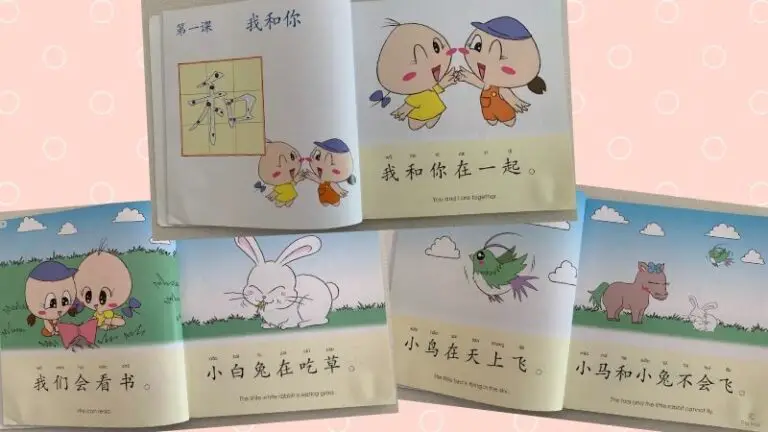
The books are sold in a set or individually, and there are 25 books in total. 5 in each colour coded reader series, comprising of
- Beginner reader (Blue). Recommended for ages 3+
- Budding reader (Green). Recommended for ages 3 to 3.5
- Emergent reader (Orange). Recommended for ages 4+
- Fluent reader (Pink). Recommended for ages 4 to 4.5/5
- Confident reader (Red). Recommended for ages 5+
Language versions are Simplified Chinese or Traditional Chinese.
Each book is made up of 20 mini lessons, with each lesson targeting only 1 Chinese word. Thus, by the end of each book, your child would have been taught 20 Chinese words (please note that I used the word taught, and not learnt. It will take more than reading a book to learn a word. More on that later!)
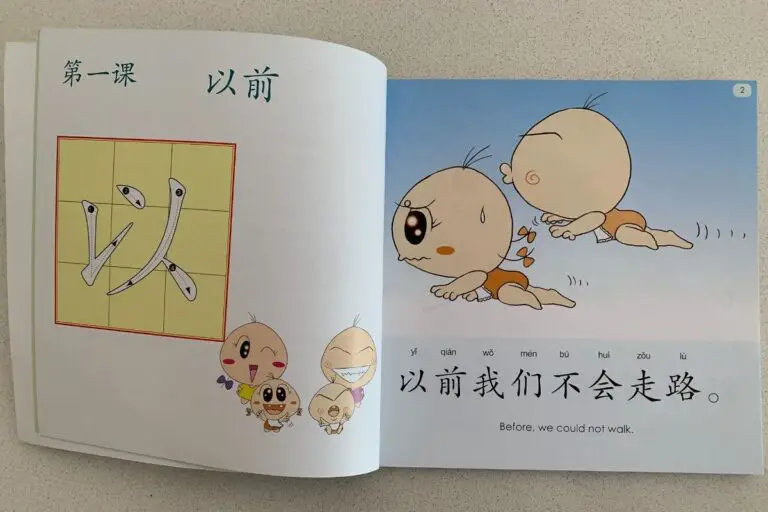
In total, each series comprises 5 books, and targets 100 Chinese words. The target Chinese word is shown with the numbered stroke order. There is only one sentence for each picture. Each lesson is short, only 4-5 pages long, with simple sentences accompanying each picture. It should only take you 1 minute to read 1 lesson.
The beauty of these leveled readers is that each reader builds upon the previous ones. Your child is only taught one Chinese word in each lesson, so with this series of readers, this means that your child can be very fluent and confident if you stick to the recommended sequence, and make sure that your child has mastered the words in the previous books before moving on to the next one.
And by the end of the series, your child would have been extensively exposed to 500 basic Chinese words!
My personal experience
For Da Bao, I started him on the series when he was 3 years old. It was a pain getting him to read him. He was not interested at all, and getting him to even sit and look at the book was tedious. Nevertheless Mummy persisted. And after 2 years of on and off reading, he is now reading fluently at the orange level.
For Er Bao, I managed to get her to read the books at 4 years old. And she actually enjoyed reading the books, and gets a real sense of accomplishment when she can read the sentences independently. Perhaps because she was a bit older when we started?
Xiao Bao is turning 3 soon, so I have yet to intensively start her on the readers, though she has heard her siblings read.
My Tips
Only get your child to independently read as much as they can handle. For some children, it can be as short as 2 or 3 lessons, some children might go up to ten lessons in one sitting. Every child is different. The key is to not push it so far that they find it a chore. Do a little, but do it well.
Repeat the series as needed. As this series is meant to build upon the previous vocabulary learnt, if your child has not mastered the previous words, you should not move on to the next lessons. If you are getting stuck. Give it a break and come back in a week or two.
Set a time daily to read the books. Make it a daily habit.
Praise their very little improvement and success!
Supplementary Teaching Materials
To ensure that my children has truly and properly learnt the words in the books, I use supplementary teaching materials to complement their learning. This includes the use of flashcards, posters and writing worksheets. Again, moderation is key, and a little practice goes a long way when done right.
Sage Books Hong Kong has some free teaching materials online. Cantonese for Families has a fabulous guide to Sage Books Chinese teaching materials. A lot of them are in Traditional Chinese though.
What I like about it
As an educator myself, I love how focused each lesson is. For beginner readers, it does help to focus and repeat the targeted vocabulary for optimal learning.
I like that each lesson starts off with the Chinese character that the child should learn, complete with word strokes, and its correct order. This gives the lesson a focus for the child.
The Chinese sentences are accompanied by a picture depicting the scenario described, their respective pinyin sounds, along with the English translation. Even non-native speakers can pronounce the words if they have knowledge of the four tones. The pinyin can also come in handy as a prompt for early Chinese readers, who are not so confident initially. (Please do cover them up later on with a strip of paper if your child becomes overly reliant on the pinyin).
**The magic of these readers only works if you follow them diligently!! Make sure your child has mastered the words in that series before you move on to the next one, and very soon your child will be able to read Chinese words independently!
What I don’t like about it
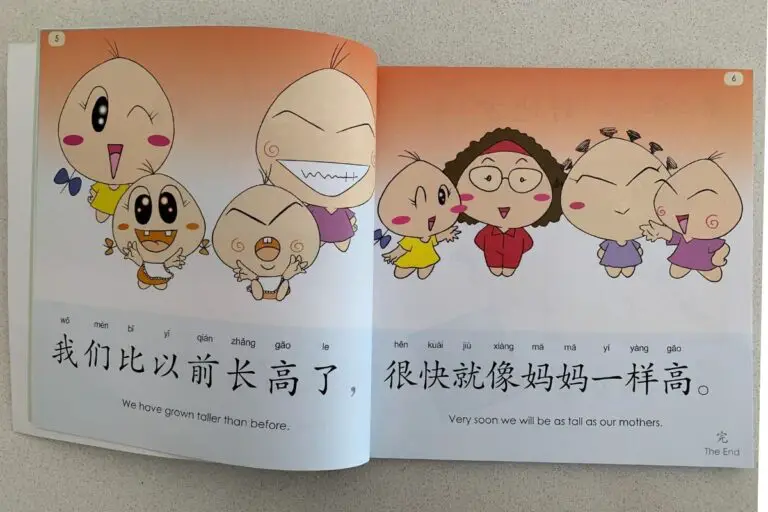
The pictures are not very attractive. To the new age generation of kids who are constantly lured by pretty images, these picture books need a serious update!
Did I mention how annoying the first book is? The repetition of 高山 is completely redundant!!! It is repeated countless times!! Surely you can be learning some other new vocabulary or sentences in those pages.
And the books are not exactly stories. So it can be hard to engage your child (as evident from my first born who did not like to at all!)
It is very expensive. Shudder…
So how much do the books cost?
Depending on where you are located, you can buy the books as a set on the official SBHK site or individually at bookstores such as Seeds, Yesasia, local bookstores in Singapore and Malaysia (which is where we got ours) .
For instance, if you purchase the entire set online on the SBHK website, the entire series will set you back HKD$2280, approximately USD$315. Shipping will set you back USD$98.
In Singapore/Malaysia bookstores, you can get individual books at the local books for approximately SGD$7 each.
If you are keen to try it out, I really recommend that you get the entire set instead of individual books. Because the reading program only works effectively if it is used in the precise reading order. As mentioned, each lesson builds upon the previous ones, so if you miss even 1 book, you miss out on 20 Chinese words which are then repeated in the subsequent books.
I made the mistake of getting them individually in Singapore, and when I wanted to complete the series, it was far more tedious than I expected! And unfortunately, as of 2022, Sage Books are pulling their sales out of Singapore and Malaysia, so if you find any of the individual titles, they are likely to be old stock, and it is getting very hard to complete the full set, as a few readers ahem shared with me.
So if you want to utilise this series properly, you have to take the plunge and invest in it. Both time and money (quite a lot of money I know!).
The ultimate question: should I buy it?
Ask yourself these questions
- Will you be using it for more than 1 child?
- Will you stick to the reading program according to the recommended reading schedule?
- Will you use supplementary teaching materials?
If you answered YES to all the questions, just pay the money and get it. If you stick at it, these readers will give you excellent results. If you are not sure if these leveled readers are for you, you can consider these other more cost effective options:
- Odonata Readers (Read our full review in this blog post to find out why we love them)
- Sinolingua Readers
- Greenfield Readers
OK I'm in. I think this leveled reader will work for my family. Where can I buy it?
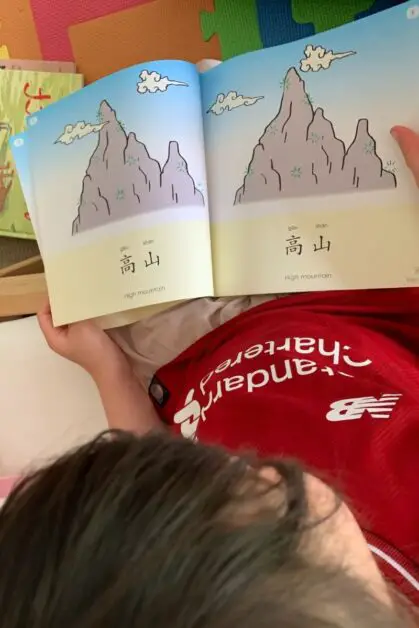
Sage Books Hong Kong official website
Seeds Children Bookstore Hong Kong -Traditional Chinese version only
YesAsia – Traditional Chinese version only
Gloria’s Bookstore USA – Traditional Chinese version only
Little Kozzi Canda – Traditional Chinese version only
Popular Bookstores Singapore/Malaysia – Simplified Chinese version only (old stock)
MPH Bookstores Singapore/Malaysia – Simplified Chinese version only (old stock)
Lazada Singapore – Simplified Chinese version only (old stock)
Good luck teaching! If you need related resources, do grab them from the links on this page!
我们一起开心教中文。
Let’s teach mandarin the fun and easy way.
Please note: this is my honest to goodness review, and my personal opinion and experience (not sponsored!). Your child and family experience may be different from mine.
Reviews from other Mandarin Chinese homeschoolers/parent bloggers
See what other Mandarin Chinese parent bloggers have to say

Pingback: Book Review: My First Book of Chinese words - Mandarin Home School
Pingback: Book Review: 幼儿学句型 Learn Sentences - Mandarin Home School
Pingback: Chinese Book Recommendation: Rainbow Dragon Levelled Readers - Mandarin Home School
Pingback: Free Chinese Bookmark Printables - Mandarin Home School
Pingback: Comparison of character lists in Chinese graded readers – Lah Lah Banana
Pingback: Free Sage Books Basic Chinese 500 Assessment Guide - Mandarin Home School
Pingback: Learning Log July 2021 - Mandarin Home School
Pingback: Cute Chinese Readers perfect for little Chinese learners - Cool Panda - Mandarin Home School
What would be the best readers for an English family using mandarin as a second language? Is there any readers that tell you what the character is in English first?
Hi Jenna. My suggestion for you is to use the Wawayaya Pro Reader App. There are additional language features which will translate the Chinese character to English. There are also many books on the app with pinyin feature which you might find useful. I have written a blog post about it which will give you the full details of this app.
I would also encourage you to look up Easy Steps to Chinese for kids by Yamin Ma and Xinying Li. It’s a great teaching resource guide that supports non-Chinese speaking children to learn the language through simple themed lessons.